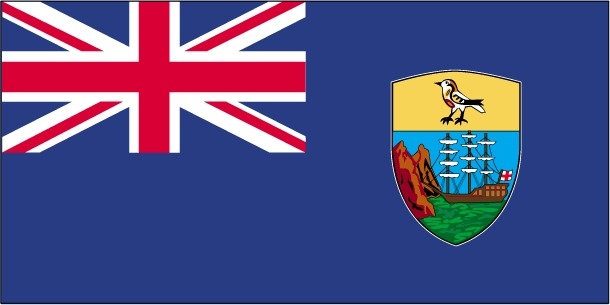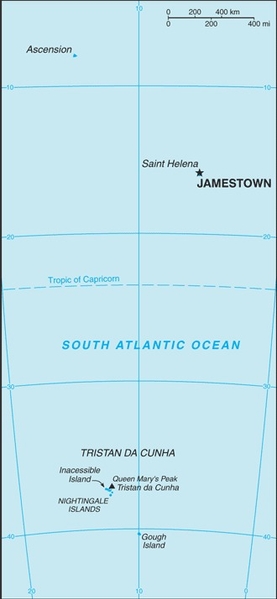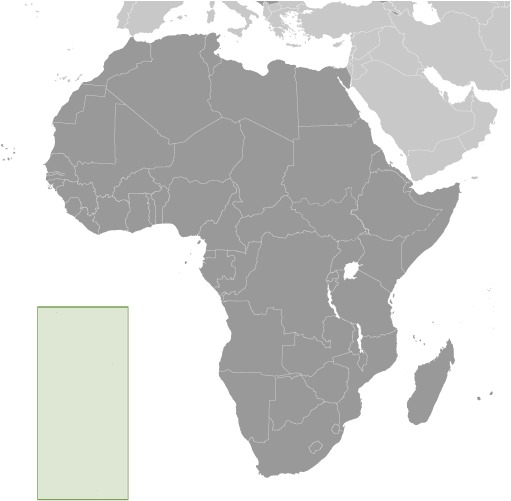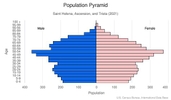Saint Helena, Ascension, and Tristan da Cunha
Introduction
Background
Saint Helena is a British Overseas Territory consisting of Saint Helena and Ascension Islands, and the island group of Tristan da Cunha.
Saint Helena: Uninhabited when first discovered by the Portuguese in 1502, Saint Helena was garrisoned by the British during the 17th century. It acquired fame as the place of Napoleon BONAPARTE's exile from 1815 until his death in 1821, but its importance as a port of call declined after the opening of the Suez Canal in 1869. During the Anglo-Boer War in South Africa, several thousand Boer prisoners were confined on the island between 1900 and 1903.;
Saint Helena is one of the most remote populated places in the world. The British Government committed to building an airport on Saint Helena in 2005. After more than a decade of delays and construction, a commercial air service to South Africa via Namibia was inaugurated in October of 2017. The weekly service to Saint Helena from Johannesburg via Windhoek in Namibia takes just over six hours (including the refueling stop in Windhoek) and replaces the mail ship that had made a five-day journey to the island every three weeks.;
Ascension Island: This barren and uninhabited island was discovered and named by the Portuguese in 1503. The British garrisoned the island in 1815 to prevent a rescue of Napoleon from Saint Helena. It served as a provisioning station for the Royal Navy's West Africa Squadron on anti-slavery patrol. The island remained under Admiralty control until 1922, when it became a dependency of Saint Helena. During World War II, the UK permitted the US to construct an airfield on Ascension in support of transatlantic flights to Africa and anti-submarine operations in the South Atlantic. In the 1960s the island became an important space tracking station for the US. In 1982, Ascension was an essential staging area for British forces during the Falklands War. It remains a critical refueling point in the air-bridge from the UK to the South Atlantic.;
The island hosts one of four dedicated ground antennas that assist in the operation of the Global Positioning System (GPS) navigation system (the others are on Diego Garcia (British Indian Ocean Territory), Kwajalein (Marshall Islands), and at Cape Canaveral, Florida (US)). NASA and the US Air Force also operate a Meter-Class Autonomous Telescope (MCAT) on Ascension as part of the deep space surveillance system for tracking orbital debris, which can be a hazard to spacecraft and astronauts.
Tristan da Cunha: The island group consists of Tristan da Cunha, Nightingale, Inaccessible, and Gough Islands. Tristan da Cunha, named after its Portuguese discoverer (1506), was garrisoned by the British in 1816 to prevent any attempt to rescue Napoleon from Saint Helena. Gough and Inaccessible Islands have been designated World Heritage Sites. South Africa leases a site for a meteorological station on Gough Island.
Visit the Definitions and Notes page to view a description of each topic.
Geography
Location
islands in the South Atlantic Ocean, about midway between South America and Africa; Ascension Island lies 1,300 km (800 mi) northwest of Saint Helena; Tristan da Cunha lies 4,300 km (2,700 mi) southwest of Saint Helena
Geographic coordinates
Saint Helena: 15 57 S, 5 42 W;
Ascension Island: 7 57 S, 14 22 W;
Tristan da Cunha island group: 37 15 S, 12 30 W
Map references
Africa
Area
total: 394 sq km
land: 122 sq km Saint Helena Island
water: 0 sq km
88 sq km Ascension Island, 184 sq km Tristan da Cunha island group (includes Tristan (98 sq km), Inaccessible, Nightingale, and Gough islands)
Area - comparative
slightly more than twice the size of Washington, DC
Land boundaries
total: 0 km
Coastline
Saint Helena: 60 km
Ascension Island: NA
Tristan da Cunha (island only): 34 km
Maritime claims
territorial sea: 12 nm
exclusive fishing zone: 200 nm
Climate
Saint Helena: tropical marine; mild, tempered by trade winds;
Ascension Island: tropical marine; mild, semi-arid;
Tristan da Cunha: temperate marine; mild, tempered by trade winds (tends to be cooler than Saint Helena)
Terrain
the islands of this group are of volcanic origin associated with the Atlantic Mid-Ocean Ridge
Saint Helena: rugged, volcanic; small scattered plateaus and plains;
Ascension: surface covered by lava flows and cinder cones of 44 dormant volcanoes; terrain rises to the east;
Tristan da Cunha: sheer cliffs line the coastline of the nearly circular island; the flanks of the central volcanic peak are deeply dissected; narrow coastal plain lies between The Peak and the coastal cliffs
Elevation
highest point: Queen Mary's Peak on Tristan da Cunha 859 m; Green Mountain on Ascension Island 818 m; Mount Actaeon on Saint Helena Island 2,060 m
lowest point: Atlantic Ocean 0 m
Natural resources
fish, lobster
Land use
agricultural land: 30.8% (2018 est.)
arable land: 10.3% (2018 est.)
permanent crops: 0% (2018 est.)
permanent pasture: 20.5% (2018 est.)
forest: 5.1% (2018 est.)
other: 64.1% (2018 est.)
Irrigated land
0 sq km (2012)
Population distribution
Saint Helena - population is concentrated in and around the capital Jamestown in the northwest, with another significant cluster in the interior Longwood area; Ascension - largest settlement, and location of most of the population, is Georgetown; Tristan da Cunha - most of the nearly 300 inhabitants live in the northern coastal town of Edinburgh of the Seven Seas
Natural hazards
active volcanism on Tristan da Cunha
volcanism: the island volcanoes of Tristan da Cunha (2,060 m) and Nightingale Island (365 m) experience volcanic activity; Tristan da Cunha erupted in 1962 and Nightingale in 2004
Geography - note
Saint Helena harbors at least 40 species of plants unknown elsewhere in the world; Ascension is a breeding ground for sea turtles and sooty terns; Queen Mary's Peak on Tristan da Cunha is the highest island mountain in the South Atlantic and a prominent landmark on the sea lanes around southern Africa
People and Society
Population
7,915 (July 2021 est.)
note: Saint Helena's Statistical Office estimated the resident population to be 4,439 in 2021; only Saint Helena, Ascension, and Tristan da Cunha islands are inhabited, none of the other nearby islands/islets are
Nationality
noun: Saint Helenian(s)
adjective: Saint Helenian
note: referred to locally as "Saints"
Ethnic groups
African descent 50%, White 25%, Chinese 25%
Languages
English
Religions
Protestant 75.9% (includes Anglican 68.9, Baptist 2.1%, Seventh Day Adventist 1.8%, Salvation Army 1.7%, New Apostolic 1.4%), Jehovah's Witness 4.1%, Roman Catholic 1.2%, other 2.5% (includes Baha'i), unspecified 0.8%, none 6.1%, no response 9.4% (2016 est.)
note: data represent Saint Helena only
Demographic profile
The vast majority of the population of Saint Helena, Ascension, and Tristan da Cunha live on Saint Helena. Ascension has no indigenous or permanent residents and is inhabited only by persons contracted to work on the island (mainly with the UK and US military or in the space and communications industries) or their dependents, while Tristan da Cunha – the main island in a small archipelago – has fewer than 300 residents. The population of Saint Helena consists of the descendants of 17th century British sailors and settlers from the East India Company, African slaves, and indentured servants and laborers from India, Indonesia, and China. Most of the population of Ascension are Saint Helenians, Britons, and Americans, while that of Tristan da Cunha descends from shipwrecked sailors and Saint Helenians.
Change in Saint Helena’s population size is driven by net outward migration. Since the 1980s, Saint Helena’s population steadily has shrunk and aged as the birth rate has decreased and many working-age residents left for better opportunities elsewhere. The restoration of British citizenship in 2002 accelerated family emigration; from 1998 to 2008 alone, population declined by about 20%.
In the last few years, population has experienced some temporary growth, as foreigners and returning Saint Helenians, have come to build an international airport, but numbers are beginning to fade as the project reaches completion and workers depart. In the long term, once the airport is fully operational, increased access to the remote island has the potential to boost tourism and fishing, provide more jobs for Saint Helenians domestically, and could encourage some ex-patriots to return home. In the meantime, however, Saint Helena, Ascension, and Tristan da Cunha have to contend with the needs of an aging population. The elderly population of the islands has risen from an estimated 9.4% in 1998 to 20.4% in 2016.
Age structure
0-14 years: 14.86% (male 599/female 577)
15-24 years: 11.84% (male 477/female 460)
25-54 years: 42.59% (male 1,679/female 1,692)
55-64 years: 13.18% (male 514/female 529)
65 years and over: 17.54% (male 710/female 678) (2021 est.)
Dependency ratios
total dependency ratio: NA
youth dependency ratio: NA
elderly dependency ratio: NA
potential support ratio: NA
Median age
total: 43.2 years
male: 43.2 years
female: 43.3 years (2020 est.)
Population distribution
Saint Helena - population is concentrated in and around the capital Jamestown in the northwest, with another significant cluster in the interior Longwood area; Ascension - largest settlement, and location of most of the population, is Georgetown; Tristan da Cunha - most of the nearly 300 inhabitants live in the northern coastal town of Edinburgh of the Seven Seas
Urbanization
urban population: 40.3% of total population (2021)
rate of urbanization: 0.98% annual rate of change (2020-25 est.)
Major urban areas - population
1,000 JAMESTOWN (capital) (2018)
Sex ratio
at birth: 1.06 male(s)/female
0-14 years: 1.04 male(s)/female
15-24 years: 1.04 male(s)/female
25-54 years: 0.99 male(s)/female
55-64 years: 0.97 male(s)/female
65 years and over: 1.04 male(s)/female
total population: 1.01 male(s)/female (2020 est.)
Infant mortality rate
total: 19.77 deaths/1,000 live births
male: 23.74 deaths/1,000 live births
female: 15.6 deaths/1,000 live births (2021 est.)
Life expectancy at birth
total population: 80.25 years
male: 77.34 years
female: 83.31 years (2021 est.)
Drinking water source
improved: total: 100% of population
unimproved: total: 0% of population (2017 est.)
Sanitation facility access
improved: total: 100% of population
unimproved: total: 0% of population (2017)
Environment
Environment - current issues
development threatens unique biota on Saint Helena
Climate
Saint Helena: tropical marine; mild, tempered by trade winds;
Ascension Island: tropical marine; mild, semi-arid;
Tristan da Cunha: temperate marine; mild, tempered by trade winds (tends to be cooler than Saint Helena)
Land use
agricultural land: 30.8% (2018 est.)
arable land: 10.3% (2018 est.)
permanent crops: 0% (2018 est.)
permanent pasture: 20.5% (2018 est.)
forest: 5.1% (2018 est.)
other: 64.1% (2018 est.)
Urbanization
urban population: 40.3% of total population (2021)
rate of urbanization: 0.98% annual rate of change (2020-25 est.)
Government
Country name
conventional long form: Saint Helena, Ascension, and Tristan da Cunha
conventional short form: none
etymology: Saint Helena was discovered in 1502 by Galician navigator Joao da NOVA, sailing in the service of the Kingdom of Portugal, who named it "Santa Helena"; Ascension was named in 1503 by Portuguese navigator Afonso de ALBUQUERQUE who sighted the island on the Feast Day of the Ascension; Tristan da Cunha was discovered in 1506 by Portuguese explorer Tristao da CUNHA who christened the main island after himself (the name was subsequently anglicized)
Government type
parliamentary democracy
Dependency status
Overseas Territory of the UK
Capital
name: Jamestown
geographic coordinates: 15 56 S, 5 43 W
time difference: UTC 0 (5 hours ahead of Washington, DC, during Standard Time)
etymology: founded in 1659 and named after James, Duke of York, who would become King James II of England (r. 1785-1788)
Administrative divisions
3 administrative areas; Ascension, Saint Helena, Tristan da Cunha
Independence
none (overseas territory of the UK)
National holiday
Birthday of Queen ELIZABETH II, third Monday in April (1926)
Constitution
history: several previous; latest effective 1 September 2009 (St Helena, Ascension and Tristan da Cunha Constitution Order 2009)
Legal system
English common law and local statutes
Citizenship
see United Kingdom
Suffrage
18 years of age
Executive branch
chief of state: Queen ELIZABETH II (since 6 February 1952)
head of government: Governor Philip RUSHBROOK (since 11 May 2019)
cabinet: Executive Council consists of the governor, 3 ex-officio officers, and 5 elected members of the Legislative Council
elections/appointments: none; the monarchy is hereditary; governor appointed by the monarch
note: the constitution order provides for an administrator for Ascension and Tristan da Cunha appointed by the governor
Legislative branch
description: unicameral Legislative Council (17 seats including the speaker and deputy speaker; 12 members directly elected in a single countrywide constituency by simple majority vote and 3 ex-officio members - the chief secretary, financial secretary, and attorney general; members serve 4-year terms)
elections: last held on 13 October 2021 (next to be held in 2025)
election results: percent of vote - NA; seats by party - independent 12; composition - men 14, women 3, percent women 17.6%
note: the Constitution Order provides for separate Island Councils for both Ascension and Tristan da Cunha
Judicial branch
highest courts: Court of Appeal (consists of the court president and 2 justices); Supreme Court (consists of the chief justice - a nonresident - and NA judges); note - appeals beyond the Court of Appeal are heard by the Judicial Committee of the Privy Council (in London)
judge selection and term of office: Court of Appeal and Supreme Court justices appointed by the governor acting upon the instructions from a secretary of state acting on behalf of Queen ELIZABETH II; justices of both courts serve until retirement at age 70, but terms can be extended
subordinate courts: Magistrates' Court; Small Claims Court; Juvenile Court
Diplomatic representation in the US
none (overseas territory of the UK)
Diplomatic representation from the US
embassy: none (overseas territory of the UK)
Flag description
blue with the flag of the UK in the upper hoist-side quadrant and the Saint Helenian shield centered on the outer half of the flag; the upper third of the shield depicts a white plover (wire bird) on a yellow field; the remainder of the shield depicts a rocky coastline on the left, offshore is a three-masted sailing ship with sails furled but flying an English flag
National symbol(s)
Saint Helena plover (bird)
National anthem
note: as a territory of the UK, "God Save the Queen" is official (see United Kingdom)
Economy
Economic overview
The economy depends largely on financial assistance from the UK, which amounted to about $27 million in FY06/07 or more than twice the level of annual budgetary revenues. The local population earns income from fishing, raising livestock, and sales of handicrafts. Because there are few jobs, 25% of the work force has left to seek employment on Ascension Island, on the Falklands, and in the UK.
GDP - composition, by sector of origin
agriculture: NA
industry: NA
services: NA
Agricultural products
coffee, corn, potatoes, vegetables; fish, lobster; livestock; timber
Industries
construction, crafts (furniture, lacework, fancy woodwork), fishing, collectible postage stamps
Labor force - by occupation
agriculture: 6%
industry: 48%
services: 46% (1987 est.)
Household income or consumption by percentage share
lowest 10%: NA
highest 10%: NA
Budget
revenues: 8.427 million (FY06/07 est.)
expenditures: 20.7 million (FY06/07 est.)
note: revenue data reflect only locally raised revenues; the budget deficit is resolved by grant aid from the UK
Fiscal year
1 April - 31 March
Exports - partners
United States 47%, Japan 12%, South Korea 10%, France 9%, Australia 5% (2019)
Exports - commodities
crustaceans, fish, integrated circuits, air conditioners, clothing and apparel (2019)
Imports - partners
United Kingdom 65%, South Africa 21% (2019)
Imports - commodities
refined petroleum, cranes, communion wafers, iron sheeting, cars and vehicle parts (2019)
Exchange rates
Saint Helenian pounds (SHP) per US dollar -
0.7836 (2017 est.)
0.6542 (2016 est.)
0.6542 (2015)
0.607 (2014 est.)
0.6391 (2013 est.)
Energy
Electricity - from fossil fuels
100% of total installed capacity (2016 est.)
country comparison to the world: 16Electricity - from nuclear fuels
0% of total installed capacity (2017 est.)
country comparison to the world: 171Electricity - from hydroelectric plants
0% of total installed capacity (2017 est.)
country comparison to the world: 194Electricity - from other renewable sources
0% of total installed capacity (2017 est.)
country comparison to the world: 204Communications
Telephones - fixed lines
total subscriptions: 3,000 (2018)
subscriptions per 100 inhabitants: 49.93 (2018 est.)
Telephones - mobile cellular
total subscriptions: 4,000 (2018)
subscriptions per 100 inhabitants: 66.58 (2019 est.)
Telecommunication systems
general assessment: capability to communicate worldwide; ADSL- broadband service; LTE coverage of 95% of population, includes voice calls, text messages, mobile data as well as inbound and outbound roaming; Wi-Fi hotspots in Jamestown, 1 ISP, many services are not offered locally but made available for visitors; some sun outages due to the reliance of international telephone and Internet communication relying on single satellite link (2020)
domestic: automatic digital network; fixed-line 50 per 100 and mobile-cellular 67 per 100 persons (2019)
international: country code (Saint Helena) - 290, (Ascension Island) - 247; landing point for the SaEx1 submarine cable providing connectivity to South Africa, Brazil, Virginia Beach (US) and islands in Saint Helena, Ascension and Tristan de Cunha; international direct dialing; satellite voice and data communications; satellite earth stations - 5 (Ascension Island - 4, Saint Helena - 1) (2019)
note: the COVID-19 pandemic continues to have a significant impact on production and supply chains globally; since 2020, some aspects of the telecom sector have experienced downturn, particularly in mobile device production; many network operators delayed upgrades to infrastructure; progress towards 5G implementation was postponed or slowed in some countries; consumer spending on telecom services and devices was affected by large-scale job losses and the consequent restriction on disposable incomes; the crucial nature of telecom services as a tool for work and school from home became evident, and received some support from governments
Broadcast media
Saint Helena has no local TV station; 2 local radio stations, one of which is relayed to Ascension Island; satellite TV stations rebroadcast terrestrially; Ascension Island has no local TV station but has 1 local radio station and receives relays of broadcasts from 1 radio station on Saint Helena; broadcasts from the British Forces Broadcasting Service (BFBS) are available, as well as TV services for the US military; Tristan da Cunha has 1 local radio station and receives BFBS TV and radio broadcasts
Internet country code
.sh; note - Ascension Island assigned .ac
Internet users
total: 2,281 (2020 est.)
percent of population: 23.1% (July 2016 est.)
Broadband - fixed subscriptions
total: 1,000 (2017 est.)
subscriptions per 100 inhabitants: 16.64 (2019 est.)
Communications - note
Ascension Island hosts one of four dedicated ground antennas that assist in the operation of the Global Positioning System (GPS) navigation system (the others are on Diego Garcia (British Indian Ocean Territory), Kwajalein (Marshall Islands), and at Cape Canaveral, Florida (US)); South Africa maintains a meteorological station on Gough Island in the Tristan da Cunha archipelago
Transportation
Airports - with paved runways
total: 2
over 3,047 m: 1 Ascension Island - Wideawake Field (ASI)
1,524 to 2,437 m: 1 Saint Helena (HLE); (2019)
note - weekly commercial air service to South Africa via Namibia commenced on 14 October 2017
Roadways
total: 198 km (Saint Helena 138 km, Ascension 40 km, Tristan da Cunha 20 km) (2002)
paved: 168 km (Saint Helena 118 km, Ascension 40 km, Tristan da Cunha 10 km) (2002)
unpaved: 30 km (Saint Helena 20 km, Tristan da Cunha 10 km) (2002)
Ports and terminals
major seaport(s): Saint Helena
Saint Helena: Jamestown
Ascension Island: Georgetown
Tristan da Cunha: Calshot Harbor (Edinburgh)
Transportation - note
the new airport on Saint Helena opened for limited operations in July 2016, and the first commercial flight took place on 14 October 2017, marking the start of weekly air service between Saint Helena and South Africa via Namibia; the military airport on Ascension Island is closed to civilian traffic; there is no air connection to Tristan da Cunha and very limited sea connections making it one of the most isolated communities on the planet
Military and Security
Military - note
defense is the responsibility of the UK




